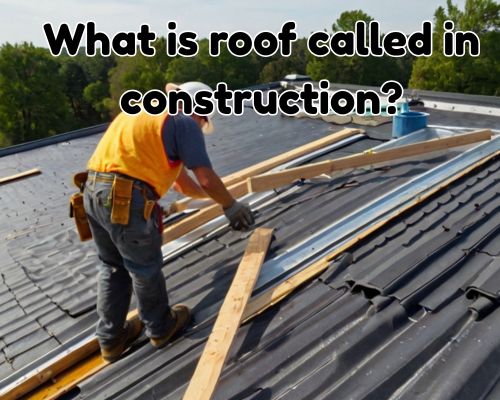
What is Roof Called in Construction? A Comprehensive Guide for New Jersey Homeowners
When it comes to residential or commercial buildings, the roof is undeniably one of the most vital structural components. Yet, if you’ve ever asked yourself, “What is roof called in construction?”, you’re not alone. Whether you’re a homeowner in Newark or a builder working in Princeton, understanding roofing terminology is essential for clear communication, project planning, and budgeting.

With Charles Jimerson of CJ Commercial Roofing NJ, we’ll break down the terminology and roles of the roof in construction, explain its parts, and highlight relevant construction jargon. Plus, we’ll contextualize it for New Jersey’s unique climate and building codes to make sure you’re fully in the know.
The Basic Definition: What is Roof Called in Construction?
In the construction industry, the term roof typically refers to the structural system covering the top of a building that protects it from weather, water infiltration, and environmental elements. But more precisely, the roof in construction is known as the roof assembly or roof system.
A roof system is not just a simple layer on top; it’s a complex assembly of multiple components working together to ensure structural integrity and weatherproofing. The main elements include:
- Roof Decking (Sheathing): The foundational layer, often plywood or OSB (Oriented Strand Board), attached to the building’s frame.
- Underlayment: A protective layer placed over the decking, often felt or synthetic material, acting as a moisture barrier.
- Roof Covering (or Roof Finish): The visible outermost material, such as shingles, tiles, metal panels, or slate.
- Flashing: Metal pieces installed at joints and edges to prevent water seepage.
- Insulation and Ventilation: Essential for energy efficiency and moisture control.
Salient Construction Terms for Roofs in New Jersey
Understanding roof terminology requires familiarity with these key phrases:
- Rafters: Sloping beams supporting the roof decking.
- Trusses: Prefabricated, triangulated wooden structures providing roof support.
- Eaves: The lower edges of the roof that overhang the building’s walls.
- Ridge: The horizontal line at the top where two roof slopes meet.
- Valley: The internal angle where two roof slopes intersect.
- Gutters and Downspouts: Systems directing rainwater away from the foundation.
- Pitch or Slope: The steepness of the roof, often expressed as a ratio (e.g., 4:12 pitch).
In New Jersey, these components are subject to local building codes, influenced by regional weather patterns, including snow loads in winter and heavy rain during hurricane season.
Roof Types Commonly Seen in New Jersey Construction
Knowing the terminology is one thing, but understanding roof types helps contextualize the name and function. In New Jersey, these roof types are prevalent:
- Gable Roof: The classic triangular shape with two slopes meeting at a ridge. Simple, effective for shedding water and snow.
- Hip Roof: Slopes on all four sides, converging at a ridge or point. Provides greater stability in high winds.
- Flat Roof: Common in commercial buildings or modern homes; requires proper drainage systems.
- Mansard Roof: A four-sided roof with two slopes on each side, often adding extra attic or living space.
- Shed Roof: A single sloping plane, often used for extensions or contemporary styles.
Why Knowing Roof Terminology Matters in New Jersey
Understanding what a roof is called in construction is not just academic — it has practical benefits:
- Communication with Contractors: When discussing repairs or renovations in places like Jersey City or Hoboken, clear language avoids costly misunderstandings.
- Compliance with Building Codes: New Jersey’s codes require specific materials and structural standards due to its climate — especially regarding snow loads and wind resistance.
- Budgeting & Planning: Knowing the parts and types of roofs helps homeowners estimate costs accurately, especially when choosing materials like asphalt shingles versus metal roofing.
- Insurance Claims: Roof damage claims often hinge on accurate descriptions of roof types and components.
For more, visit https://cjcommercialroofingnj.com/.
Roofing Materials Popular in New Jersey Construction
The construction term for roofing also extends to the material used. Each type serves a unique purpose and suits different building needs:
- Asphalt Shingles: The most common roofing material in New Jersey homes due to affordability and ease of installation.
- Metal Roofing: Growing in popularity for durability, longevity, and energy efficiency.
- Slate Tiles: Premium material often seen on historic homes in towns like Princeton or Morristown.
- Wood Shingles or Shakes: Provide a natural aesthetic but require maintenance and are less fire-resistant.
- Rubber Membranes (EPDM): Often used for flat roofs in commercial structures.
The Role of Roof Construction in New Jersey’s Weather Landscape
New Jersey experiences a diverse climate: humid summers, snowy winters, and occasional hurricanes. Thus, roof construction here must be robust:
- Snow Load Considerations: Roofs must be designed to bear the weight of snow and ice accumulation.
- Wind Resistance: Roof assemblies need secure flashing and anchoring to withstand strong gusts.
- Waterproofing: Effective underlayment and flashing are crucial to prevent leaks during heavy rains.
Local contractors in towns like Edison, Cherry Hill, and Atlantic City frequently reference roof assemblies instead of just “roof” to emphasize the engineered nature of the system protecting your home.
How to Discuss Your Roof Project Using Construction Terminology
If you’re embarking on a roof replacement or inspection in New Jersey, here’s how to confidently use roofing terms:
- Instead of saying “My roof is leaking,” say: “The roof assembly, particularly the underlayment or flashing, may have failed, causing water infiltration.”
- Asking your contractor: “What type of roof system and materials do you recommend for withstanding New Jersey’s winter snow loads?”
- Discussing design: “I prefer a hip roof for better wind resistance, especially in coastal towns like Long Branch or Asbury Park.”
Local Regulations and Permits for Roof Construction in New Jersey
Roof construction is regulated by the New Jersey Uniform Construction Code (UCC), which enforces standards to ensure safety and durability. Homeowners must secure permits for roof replacements or significant repairs. Key points:
- Inspections verify compliance with material quality and installation.
- Contractors must follow guidelines for energy efficiency, especially for insulation and ventilation.
- Stormwater management includes proper gutter and downspout installation to protect the foundation from runoff.
Summary: What is Roof Called in Construction in New Jersey?
In construction jargon, a roof is more than just the surface you see — it’s a roof system or roof assembly, a complex structure made of decking, underlayment, covering, flashing, and more. Understanding these terms is crucial for homeowners and builders in New Jersey, given the state’s varied climate and strict building codes.
By mastering the language of roofing—be it the ridge, eaves, valley, or trusses—you gain control over your home’s most protective shield. Whether you’re in Paterson, Edison, or Camden, knowing what your roof is called in construction means you’re better equipped to make smart decisions, communicate effectively, and ensure your roof stands up to Jersey’s weather for decades.

